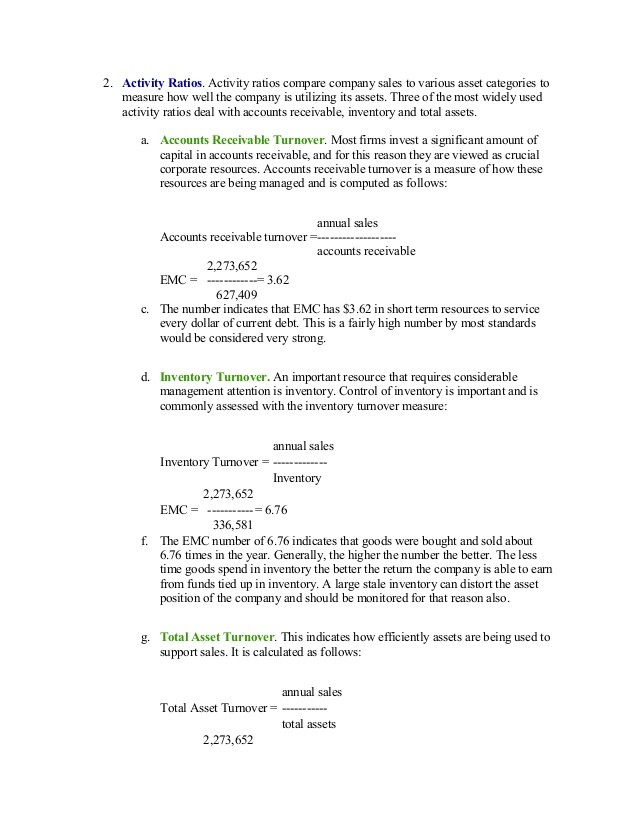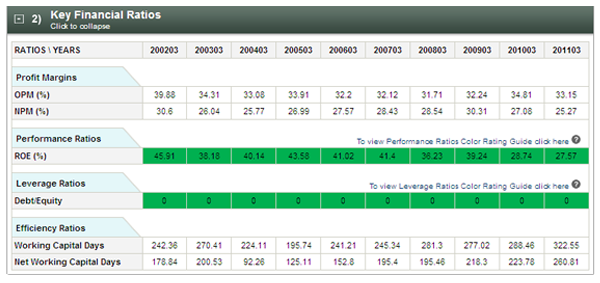Important Financial Ratios
Post on: 1 Апрель, 2015 No Comment

In the fundamental analysis school of stock investing, investors’ decisions must be based on some sound analysis that uses basic financial ratios. They use these ratios to determine the viability of gaining from purchasing or selling certain stocks. These numbers indicate financial performance, value, and profitability, among others. The main idea is to pick those that are cheaper than their intrinsic values, are performing above the rest or the market, and have huge growth prospects. They determine these by looking at a set of useful financial indicators.
Earnings per Share (EPS)
A measure of profitability is the earnings per share (EPS). Essentially, it is a measure of how much profit a company makes per share of outstanding stock. The EPS refers to the net income, after deducting dividends paid on preferred stocks, divided by the total outstanding shares. If you need to choose between two companies with the same EPS, you can pick the one that can produce the same amount of earnings but with lower amount of investment money or equity as that is the one that is more efficient. However, the EPS does not say something about the market’s sentiment or whether it’s a good stock to buy or not. Other financial ratios have to be considered in addition to the EPS such as the price-to-earnings ratio and net profit margin, among others.
Price-to-Earnings Ratio (P/E Ratio)
The price to earnings ratio or P/E ratio is simply the price per share of stock divided by earnings per share. For example, if a stock has earned $3 per share over the last 12 months and is trading at $66 per share, its P/E ratio is 22. This is the amount that investors are willing to pay for every dollar of earnings. The P/E ratio is the one number that investors look at more than any other ratio. A high P/E ratio, with all else held equal, indicates a greater willingness of the market to pay for the earnings in a company. But many investors interpret a high P/E ratio as an indicator for being overpriced. While this may be true, it is also an indication that investors have high hopes for that particular stock and this has bid up the share price.
Investors tend to select a stock with a lower P/E ratio, given two similar companies. The lower ratio indicates a greater room for price increase than in one that already has a high price. They refer to the former as one that has an intrinsic value lower than its current valuation, hence the allowance for a positive movement in its price in the future. These investors are often called value investors.
Take note that the P/E ratios of different stocks should not be compared as they have different nature. It should also be used in conjunction with other financial ratios for a more complete picture.
Price-to-Cash Flow
The price to cash flow ratio is an indication of what the market expects of a company’s financial condition in the future. This ratio, which is calculated by dividing the stock price per share by cash flow per share, reflects the relative value of a stock. The share price refers to the 30-day or 60-day average while the cash flow data to use is the firm’s trailing twelve-month cash flows per share of stock. The advantage of using cash flow as metric is that it is less susceptible to manipulations than earnings and sales. It is a solid measure of how much cash a firm has generated within a certain period. The price to cash flow ratio is said to be a reliable indicator of long-term earnings.
Take note though that there are different types of cash flows that can be used as denominator. Free cash flow is different from cash flow to stakeholders or to a simple aggregate of the different cash flows on a company’s cash statement. You have to make sure that you are comparing the same metric when looking at various companies in an industry.
PEG Ratio
The PEG ratio is another gauge used by investors to assess a stock’s value. It is like the P/E ratio but is more complete as it factors in the company’s growth performance. It is obtained by dividing P/E ratio by the growth of earnings per share or EPS for a particular period. If you take two similar stocks from the same industry with a relatively the same P/E ratio but different EPS growth, the one with the higher growth has a lower PEG ratio. That stock is similarly priced but is growing more robustly; hence it is more desired than the other. A PEG ratio with a value of less than 1 is usually preferred, although it may vary depending on the industry and type of company.
Analysts use the historical growth of the EPS for calculating the PEG. However, if they believe that growth rates in the future will differ significantly from historical rates, they use growth estimates. The resulting calculation would refer to as the forward PEG ratio. Since, many investors put more weight on future growth prospects rather than past performances of companies; they usually incorporate this indicator along with the normal PEG ratio in their decisions.
Debt-to-Equity Ratio
In choosing stocks, investors pay close attention to financial leverage. Is the company able to undertake its core operation without relying heavily on borrowings? Too much exposure to debt brings a certain degree of uncertainty to earnings that many investors cannot swallow. An important indicator of financial leverage is the debt-to-equity ratio. It refers to the proportion of debt to shareholders equity. Sometimes, investors look at the long-term borrowings instead of the total liabilities.
A company with a high debt-equity ratio means that it has been bold in using debt to finance its expansions. A high ratio can affect the level of earnings because the company needs to settle interest payments. If the earnings that the company is able to produce out of its investments financed by these borrowings are lower than the cost of the debt financing, this may result to bankruptcy.

For most companies, the ideal debt-equity ratio is 0.50. For instance, for every dollar of equity, a company has 50 cents of debt. However, the ratio varies depending on the industry since some would need more borrowings that other. Capital-intensive industries like car manufacturers require larger amount of debt to finance their operations, a debt-equity ratio of above 2 is acceptable. Makers of computers and the like tend to have ratios below 0.50.
Net profit Margin Ratio
The net profit margin is an indicator of profitability. It is calculated by dividing net income by revenues or net profits over sales. It refers to the earnings a company makes from every dollar of revenue. A 15-percent profit margin presents that the company is able to make $0.15 for every dollar of sales. A higher margin indicates greater profitability. One should compare the profit margin of relatively similar companies within the same industry. Investors also seek for companies that are able to perform higher profitability than its historical performance.
Earnings alone do not tell the complete story. Even when earnings increase, profit margin can remain unchanged if costs have likewise increased at the same rate as the growth rate in earnings. It goes down even if costs go up faster than earnings. At the same level of earnings, the company is better off when it is able to lower costs. Therefore, profit margin indicates the company’s ability to control costs. Lower costs can mean less reliance on borrowings to finance the operations of a company, if it is unable to raise money from other means like equity. As mentioned above, having a high level of debt relative to equity has some implications and therefore it is also an important financial indicator used by investors.
Return on Assets Ratio
The return on assets (ROA) ratio indicates a company’s profitability in relation to its total assets. It refers to annual earnings divided by total assets, shown as percentage. It is also referred to as return on investment or ROI. It shows how efficient the company is in managing its assets to produce earnings.
At the point of view of investors, it provides an idea how effective the company is in turning their investment money into income. Assets consist of equity and debt, which are both used to finance the business operations of the company. Before calculating ROA, some would include interest expense into net income because they prefer to use operating returns before payment of the cost of borrowing.
This ratio varies significantly depending on the industry. That is why if you compare ROA across companies, it is best to do it for similar ones. Comparing the current ROA with the historical ratios in a company is also recommended. A higher ROA is better; it means the company is generating more money with less investment. Two similar companies may be making the same amount of earnings, but investors would prefer the one who can do it with fewer assets, which would have the larger ROA.














